Georgia 10-Day Itinerary – Best places to visit in the country

Best things to see and do in Georgia in 10 days. Discover the country’s most famous landmarks and tourist hotspots in our Georgia 10-day itinerary!
This Georgia 10-day itinerary is a part of our broader travel guide for the country. We recommend you check it out for the best travel tips and the most accurate information on transportation, hotels, restaurants and best hikes in Georgia.
Georgia 10-Day Itinerary – Best Places to Visit in the Country
Though seemingly a pretty generous extension, the sad truth is that 10 days in Georgia will only allow you to explore the eastern half of the country and briefly venture into Western Georgia. This means that, aside from visiting Tbilisi and some neighboring towns, road tripping through the wine region of Kakheti and hitchhiking along the Georgian Military Highway until you make it to the mountainous landscapes of Kazbegi, you’ll still find time to discover the remarkable fortress of Akhaltsikhe and the often-overlooked city of Kutaisi, home to the UNESCO-listed Gelati Monastery. However, delving into the remote hiking regions of Svaneti or Tusheti, or taking a plunge into the Black Sea in Batumi, will have to wait for another occasion!
That being said, whether you have more or less available time in your hands, feel free to explore our alternative routes in Georgia:
- Georgia 7-Day Itinerary – What to See and Do in One Week
- Georgia 15-Day Itinerary – Highlights of Two Weeks in Georgia
So, without further ado, here are the cities, places and tourist attractions you should visit in a 10-day itinerary through Georgia:
Georgia 7-Day Itinerary: Day 1 – Tbilisi: Avlabari and the Old Town

The largest and most important city in all of Georgia, Tbilisi is the natural starting point for most Georgian travel itineraries. Surprisingly, the capital offers plenty to see and do, with most tourist attractions located in its extensive historical center that stretches along both banks of the Kura River. The city’s architecture is eclectic, and you’ll notice that while some buildings have been thoroughly renovated, most maintain this picturesque state of semi-disrepair. Nevertheless, this bizarre concoction of old buildings and terraces are an integral part of Tbilisi’s unique charm, since the historic center is still home to many local families, something increasingly rare in most European capitals. In fact, one of my favorite activities in Tbilisi is to randomly enter old buildings. That’s because, historically, the city center was a highly coveted area, where the noble and the wealthy lived comfortably and made intricate palaces out of their homes (income inequality was rampant). As such, when the Soviet Union was established, these spaces were expropriated. With a big influx of migrants coming from the provinces to work in Tbilisi’s brand-new factories, the government decided to split these former manor houses and convert them into multiple units. To this day, the downtown population still lives in these former mansions, with each tiny apartment usually surrounding a shared courtyard. As a result, when you step into a random building lobby in Tbilisi, you never really know what you’re going to find. Naturally, most of the opulent stucco works and vivid paintings have been eroded by time, but you can still find quite a few hidden gems. Such examples include the Kaleidoscope House and the Moorish House, though there are literally dozens of other sites worth stopping by.

After exploring these nearby houses, follow that up with a visit to Lado Gudiashvili Square, one of the city’s most picturesque squares, before climbing up the Betlemi Stairs. Given Tbilisi’s rather unique topography, where the center was built on the slopes of a small gorge/canyon, the city offers a wide variety of stunning viewpoints, with the Betlemi Stairs standing as one of the very best. After reaching the top and taking in the view, you’ll be a short walking distance from the Mother of Georgia Statue (a staple of the former Soviet republics) and from the imposing Narikala Fortress, the defensive structure that dominates the skyline of downtown Tbilisi. Afterwards, you’ll start heading down to the river banks through the narrow and steep alleys of Kala, the local name given to the Old Town. Unlike the rest of the city center, this particular quarter has been extensively renovated. On your way down, make sure not to miss the Juma Mosque, the city’s only Islamic place of worship, built during the Ottoman period. Once you finally make it to the riverbank, you’ll come across the fabulous quarter of Abanotubani, home to most of Tbilisi’s sulfur baths. In fact, the city was founded in its current location due to the numerous natural hot springs found underground, having developed a bathhouse culture that has been going strong for centuries. Apart from snapping a few pics of this gorgeous district, trying out at least one of the local bathhouses is a must.

Unlike Budapest, where bathhouses are made up of spacious, communal areas and pools, in Tbilisi each customer (or group) rents a private room, which is always equipped with one hot and one cold water plunge pools. Then, depending on your budget, rooms may include extras like a sauna, Turkish bath or a jacuzzi. That being said, here are a few options worth considering in Abanotubani (boking in advance is highly recommended):
- Gulo’s: Traditional bathhouse, decorated with beautiful tile mosaics. The management provides additional services, such as scrubbings and massages. Reservations via WhatsApp: +995 599 588 122. Private cabins start from 100 GEL/hour (4/5 people);
- Orbeliani: The most luxurious option, housed inside the most iconic building in Abanotubani. These are the city’s most famous and tourist-heavier baths. You can book online. Private cabins start from 100 GEL/hour (2 people);
- Sulphur Bathhouse №5: Public baths, though guests also have the option of renting a private cabin. Arguably the most authentic option on our list, but also the less “sophisticated”. Reservations for private cabins by phone (not required for the public area): +995 322 722 090. Public baths cost 10 GEL for men and 6 GEL for women. Private cabins available from 70 GEL/hour (4/5 people).
- Royal Bath House: One of the oldest baths, allegedly in operation since 1704. Reservations made by phone: +995 322 196 700. Private cabins start from 100 GEL/hour (4 people).

Feeling brand-new after soaking in the sulfur baths, you may then proceed to visit the Great Synagogue and the Sioni Cathedral, completing the rather unique task of visiting historical places of worship from the three major monotheistic religions (Islam, Judaism and Christianity) within just a few hundred meters. Finally, you’ll make it across the Kura River and pay a visit to the Metekhi Church. However, more than the church itself, the real highlight is the impressive view of the Old Town from its terrace. Crossing the river also means you’ve officially entered the district of Avlabari, once the main center of the Armenian community in the country. Though there aren’t many members of the once thriving community left, the area is still worth exploring, if only to see the gigantic Sameba Cathedral up close, as this 2004 juggernaut is one of the largest religious buildings in the world. If you’re too tired by now, this may very well be the best way to cap off your first day in Georgia. However, for those interested in the history of the Soviet Union and the Bolshevik Revolution, there is another place on our list one can’t miss out on. Known as the Stalin Underground Printing House (10 GEL), this small exhibition, located under the quarters of the current Georgian Communist Party, displays the original press used by Stalin and his comrades for printing Bolshevik and anti-imperial propaganda. The press, which was brought in from Germany in 1893, is still in the exact same place where it was first hidden, inside a dried out well, and remains an integral part of the process that would lead to – for better or for worse – one of the greatest revolutions in human history.

First day wrap-up:
- Kaleidoscope House
- Moorish House
- Lado Gudiashvili Square
- Betlemi Stairs
- Mother of Georgia Statue
- Narikala Fortress
- Kala – Old Town
- Juma Mosque
- Abanotubani Quarter
- Abanotubani Thermal Baths
- Great Synagogue
- Sioni Cathedral
- Metekhi Church
- Sameba Cathedral
- Stalin Underground Printing House
Where to eat in Georgia – Best restaurants in Avlabari and the Old Town:
- Racha Tavern (Georgian traditional)
- Elene Dariani (Georgian traditional)
- Shemomechama (Georgian traditional)
- Vakhtanguri’s Chebureki (Georgian traditional)
- Maspindzelo (Georgian traditional)
- Café Palermo (Georgian traditional)
- Cheers (pizza)
- Organique Josper (hamburgers and grilled meats)
Georgia 7-Day Itinerary: Day 2 – Tbilisi: Mtatsminda and Chugureti
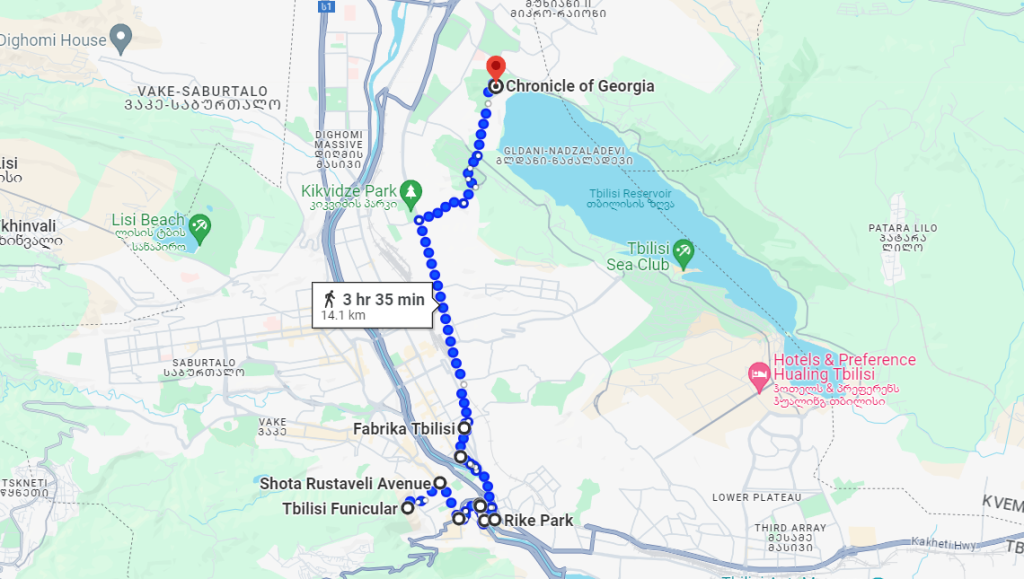
On your second and final day of exploring Tbilisi, although you’ll still spend a couple more nights in the capital, you’ll venture into the districts of Chugureti, on the other side of the river from the Old Town, and Mtatsminda, the city center area that excludes Kala (the Old Town). However, your first pit stop will take place quite far away from downtown Tbilisi, at one of the most impressive yet underrated sites in the capital: the Chronicle of Georgia monument. This monumental memorial, perched atop a staircase with a view of the water reservoir known as the Sea of Tbilisi, boasts 16 massive columns adorned with important and legendary figures from the country’s ancient history. It’s a true testament to the might of stone and metal. To get there, you can either take a combination of metro and bus (metro to Ghrmaghele station + bus 360) or just go for a taxi (around 15 GEL from the center). After visiting the monument, you’ll still have time to enjoy a filling buffet brunch at Fabrika (27 GEL). Although the food is great, this place has become a cult classic among locals, visitors and expats, coming to represent the rebirth of post-independence Georgia. Originally a Soviet sewing factory, the space has been transformed into a massive cultural center, housing cafes and restaurants, a hostel, an art gallery, a co-working space and many artistic events. In short, it’s one of the trendiest spots in Tbilisi!

After your meal, take a stroll along Davit Aghmashenebeli Avenue, one of the city’s most beautiful and bustling boulevards, before passing by Rike Park, where the cable car to Narikala Fortress departs, in case you’re up for a quick trip. After exploring Chugureti, cross the ultra-modern Bridge of Peace and you’ll be entering the district of Mtatsminda. Once you’re there, start by visiting the Anchiskhati Basilica, regarded as the oldest church in all of Georgia, before heading to the nearby Rezo Gabriadze Theatre, an old puppet amphitheater famous for its quirky building and bizarre clock tower that looks like it’s going to collapse at any moment. From there, head up the street to Freedom Square, the main gathering spot in the city for major celebrations, marches and protests, as well as the starting point of Rustaveli Avenue, Tbilisi’s main artery. As you walk along this thoroughfare, you’ll see a pretty diverse range of buildings, with totally different architectural styles often standing right next to each other. Along the way, you might as well visit the National Museum of Georgia (10 GEL), the Parliament of Georgia, St. George’s Church, the Rustaveli National Theatre and the Opera and Ballet Theatre of Tbilisi. As the day draws to a close, you’ll want to watch the sunset over the Georgian capital at Mtatsminda Park. Located atop a hill, this green area and amusement park are accessible via a funicular (16 GEL round-trip) that will take you to the park’s spectacular viewpoint.

Second day wrap-up:
- Chronicle of Georgia
- Fabrika
- Davit Aghmashenebeli Avenue
- Rike Park
- Bridge of Peace
- Anchiskhati Basilica
- Rezo Gabriadze Theater
- Liberty Square
- Rustaveli Avenue
- Georgian National Museum
- Parliament of Georgia
- Saint George’s Church
- Rustaveli National Theatre
- Opera and Ballet Theater of Tbilisi
- Mtatsminda Park (viewpoint)
Where to eat in Georgia – Best restaurants in Mtatsminda and Chugureti:
- Mapshalia (Georgian traditional)
- Batoni (Georgian traditional)
- Pasanauri (Georgian traditional)
- Salobe bia (Georgian traditional)
- Nikolozi (Georgian traditional)
- Restaurant Margalita (Georgian traditional)
- Asi Khinkali (Georgian traditional)
- Fabrika (brunch)
- Linville (varied
- Melograno (varied)
Georgia 7-Day Itinerary: Day 3 – Day trip to Mtskheta, Gori and Uplistsikhe
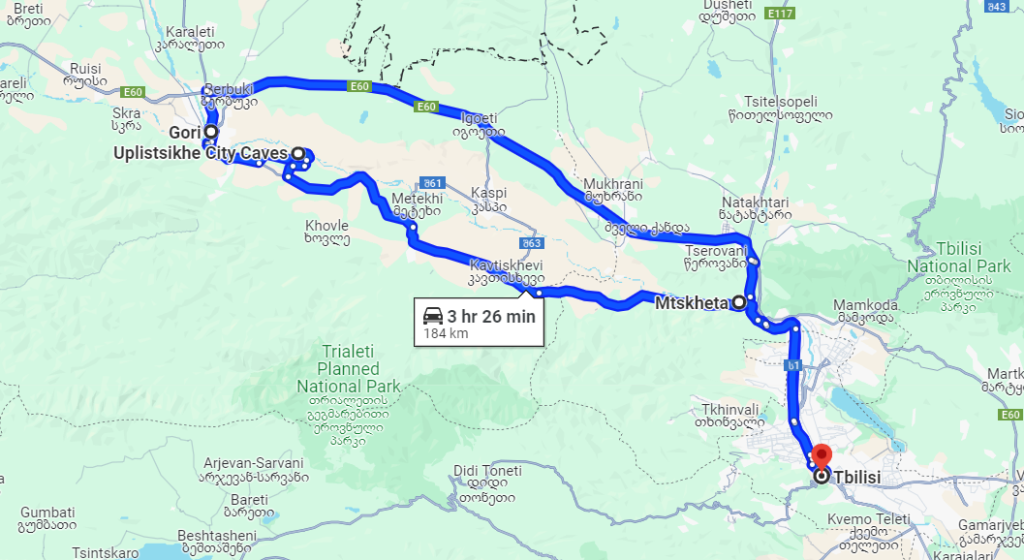
Although Tbilisi will remain your home base, this day will be dedicated to exploring three nearby towns. Therefore, you’ll turn on the early-riser mode and catch a marshrutka (specific details available in our broader Georgia travel guide) bound for Mtskheta, the country’s holiest city, often referred to as the “Vatican” of the Georgian Orthodox Church. While there are undoubtedly churches and monasteries to explore, Mtskheta offers more than just religious sites, standing out as one of the nation’s most picturesque towns and its ancient historical capital. Besides, its monuments have been designated by UNESCO as World Heritage Sites! Upon arriving in the city, located just 20 minutes away from Tbilisi, you’ll first hire a taxi (20 GEL round-trip + waiting time) to take you to the Jvari Monastery, arguably Mtskheta’s most famous spot. Perched on a hill, this church is regarded as the crib of Christianity in Georgia. Be that as it may, and no matter how beautiful the monastery is, it’s the breathtaking view of Mtskheta’s Old Town, at the confluence of the Kura and Aragvi rivers, that takes the spotlight. Once you’re ready to return, the same taxi will bring you back to the city center, where you can finally explore the charming historic center on foot. Despite its small size, this quarter boasts lovely ancient stone architecture and countless street stalls that form a sort-of impromptu bazaar. While roaming around, one cannot miss the Svetitskhoveli Cathedral, the most important church in all of Georgia. Not only is this the spiritual center of the nation and the final resting place of many of its former kings, but the cathedral is also known to house (allegedly, since you can never know for sure) the cloak worn by Christ before the crucifixion, as well as a piece of the actual wooden cross. While in Mtskheta, you can also pay a visit to the Antioch of Mtskheta, the Samtavro’s Convent and the Bebristsikhe Fortress.

Before lunch, and to make sure you can set foot on all the places we’ve planned for the day, it’s time to take another short trip inside an always-uncomfortable marshrutka – this time, the destination is the unassuming city of Gori. Birthplace of the legendary and horrific Joseph Stalin, Gori hosts one of the most unusual museums you’ll ever see. While most 20th-century bloodthirsty dictators are either loathed or ignored by their contemporary societies, the Stalin Museum (15 GEL) openly celebrates the life and work of its prodigal (if infamous) son. Additionally, visitors can explore the wooden cabin where Stalin was born, as well as main carriage of the official train where the dictator used to travel during his lengthy journeys across the vast Soviet Union. Though the museum is the undisputed highlight of Gori and its main tourist attraction, the city has other noteworthy points, such as the Gori Fortress or the Old Town, a beautiful old quarter that somehow survived the devastating earthquake of 1920. To end the day on a high note, you’ll need to find another taxi (40 GEL round-trip + waiting time) or, if you still have plenty of time, take a van from the local station and travel the 15 km that separate Gori from Uplistsikhe (15 GEL), a 4000-year-old town entirely carved into the rocky surface. Now converted into an open-air museum, it’s hard to believe that Uplistsikhe was a prominent stop on the famous Silk Road, as well as Georgia’s main city until the 13th century. Back then, even the kings and rulers lived inside these cave dwellings. After visiting the site, you’ll return to Gori, where you’ll catch another marshrutka back to Tbilisi for the night.

Third day wrap-up:
- Mtskheta
- Jvari Monastery
- Svetitskhoveli Cathedral
- Antioch of Mtshkheta
- Samtavro’s Convent
- Bebristsikhe Fortress
- Gori
- Stalin Museum
- Gori Fortress
- Old Town of Gori
- Uplistsikhe
Where to eat in Georgia – Best restaurants in Gori:
- Dzmobis Duqani (Georgian traditional)
- Berikoni (Georgian traditional)
- Chinebuli (Georgian traditional)
- Shin da Gori (Georgian traditional)
- KE&RA (Georgian traditional)
- L’Avenue (varied)
Georgia 7-Day Itinerary: Day 4 – Kakheti Road Trip

As your time in the capital comes to an end, you will once again go on a day trip, this time to the wine region of Kakheti, celebrated as the place where the world’s first wine was allegedly produced! On an important sidenote, this is the only day of the itinerary where we strongly recommend renting a car (as detailed in the general guide), given that Kakheti’s roads are generally flat, reasonably maintained and experience minimal traffic. Besides, having your own vehicle will make it much easier to explore the region’s most prominent tourist attractions. In all fairness, one would ideally need at least two days to fully experience the very best of Kakheti, but given the time constraints, we’ve crafted a special “express” itinerary, (though you’ll still need to rush a bit). If renting a car is not an option, we suggest sticking to the places mentioned in the next paragraph, as there are regular marshrutkas between Tbilisi and Sighnaghi, meaning you can at least visit this town (and the nearby monastery) using public transportation.

Now that we’re all done with the intro, let’s hit the road and head towards Sighnaghi, often promoted as the most romantic town in Georgia. It’s easy to see why. With its traditional architecture, narrow cobblestone streets and colorful balconies, it boasts those pleasing visual aesthetics reminiscent of a quintessential European small town. Plus, being perched atop a plateau, the views of the expansive and lush Alazani Valley are nothing short of breathtaking. While visiting this town, it’s worth walking along the Sighnaghi Wall, the town’s ancient defensive structure; exploring the Basilica of Saint George; climbing to the roof of St. Stephen’s Church; and checking out the Soviet memorials and mosaics at the 9th of April Park. Nevertheless, simply meandering through the streets and alleys of the city is already quite the activity, as you’ll find dozens of stalls selling the typical local embroideries, while massive, colorful carpets lean against the stone façades. Located just a 40-minute walk away from Sighnaghi (or a short taxi ride), make sure not to miss the Monastery of St. Nino at Bodbe, one of the most impressive monasteries in Kakheti, a region packed with many other worthy competitors. Plus, the road there passes by one of the best viewpoints in Sighnaghi. For another iconic view of the village and the vast valley lying down below, we also recommend the dining area of The Terrace, a local restaurant. Finally, and while the entire region is dotted with wineries and small producers offering tastings or allowing visitors to partake in the traditional wine-making process in Georgia, we recommend a tour/tasting at Pheasant’s Tears Winery (30 GEL). This winery is located in Sighnaghi, so this tip can serve both those who choose to rent a car, as well as visitors who take the marshrutka instead. As for the traditional production method in Georgia, grapes, seeds and stems are placed inside a traditional clay pot – known as qevri – and buried for 6 months, with the slow and 100% natural fermentation process giving rise to the popular local wine.

For our readers who will not be renting a car, this marks the end of your Kakheti side trip. For everyone else, it’s time to hit the road again, covering another 60 km to Telavi, the largest city in the region of Kakheti. Despite this misleading title, Telavi looks more like a village than a proper city, boasting a pretty relaxed atmosphere and some of the country’s finest traditional architecture, which you can appreciate while walking along Erekle II Street and Cholokashvili Street. Furthermore, you’ll want to take a look at the bustling Telavi Bazaar and enjoy the nice view from Nadikvari Park. However, Telavi’s standout attraction is the Batonistsikhe Castle (5 GEL), a Persian-style defensive fortress whose interior houses the Telavi Historical Museum and the Palace of King Erekle II, a former royal residence that has been recently renovated.
With the day drawing to a close, we couldn’t finish our adventure in Kakheti without recommending a visit to at least two other monasteries. The first one, the Ikalto Monastery, allows visitors to wander the ruins of an ancient 1000-year-old school and see many old qvevris up close. However, the real highlight is the spectacular Alaverdi Monastery – one of my personal favorites in Georgia!
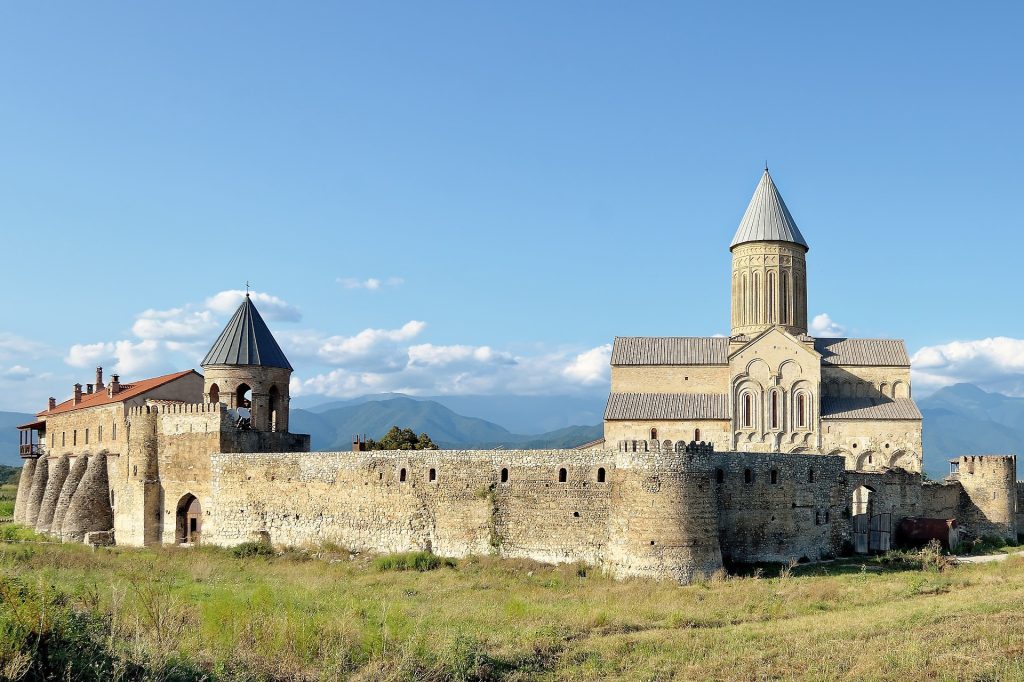
Fourth day wrap-up:
- Sighnaghi
- Sighnaghi Wall
- Basilica of Saint George
- Stephan’s Church
- 9th of April Park
- The Terrace (restaurant – amazing view)
- Pheasant’s Tears Winery (wine tasting)
- Monastery of St. Nino at Bodbe
- Telavi
- Batonistsikhe Castle (Telavi Historical Museum and Palace of King Erekle II)
- Erekle II Street
- Cholokashvili Street
- Telavi Bazaar
- Nadikvari Park
- Ikalto Monastery
- Alaverdi Monastery
Where to eat in Georgia – Best restaurants in Sighnaghi and Telavi:
- Lali (Georgian traditional)
- Varikelebi (Georgian traditional)
- The Terrace (Georgian traditional)
- Pheasant’s Tears (Georgian traditional)
- Kusika (Georgian traditional)
- Natella (Georgian traditional)
- Doli (Georgian traditional)
- Bravo (Georgian traditional)
- Zodiako (Georgian traditional)
- Kapiloni (Georgian traditional)
Georgia 7-Day Itinerary: Day 5 – Georgian Military Highway

Although it may sound odd to us, Westerners, hitchhiking is actually a relatively common practice in the Caucasus. Therefore, it’s not unusual to spot locals extending their arms for a lift in some of the most remote areas. Therefore, because it’s so ingrained in the culture, hitchhiking in Georgia is extremely easy, and you’ll seldom find yourself waiting more than 5 or 10 minutes until someone stops. Well, since are several noteworthy spots along the Georgian Military Highway, the modern road that links Georgia to Russia and reaches a staggering altitude of over 2400 meters, why not put this theory to the test? After all, your base for the next few days will be Kazbegi (also known as Stepantsminda), a town that is also located along the same iconic highway, so it makes sense to try to see as many places as possible on the way! Without further ado, start your journey by taking a marshrutka to Kazbegi from the Didube terminal in Tbilisi. This marshrutka will follow the Georgian Military Highway, but instead of completing the journey, you’ll ask to be dropped off at the Ananuri Fortress, the first highlight of the day. Located on the shores of the Zhinvali Reservoir, this fortress houses a Georgian Orthodox church and is an exceptionally beautiful place. Entry is free, and you can climb the walls to enjoy panoramic views of the complex’s domes standing against the backdrop of the reservoir’s waters.
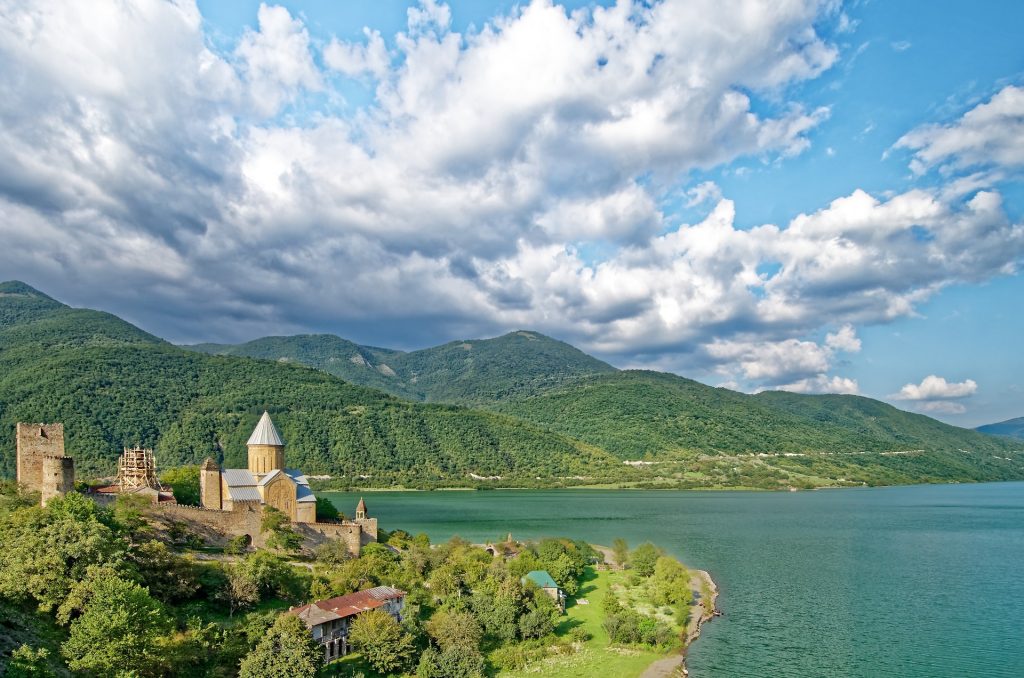
Once you’re ready to keep going, just stand by the side of the road and lift your thumb. To ease you up a bit, we need to let you know our choice was far from innocent, since this is likely the easiest spot in the country to hitchhike. The road is in excellent condition, traffic flow is good enough (meaning you won’t have to wait long for cars to pass) and you won’t even face the challenge of having to find a specific ride heading to your exact destination, since pretty much every car/truck is either heading to Kazbegi or to the Russian border. As such, I bet it won’t take you more than 5 or 10 minutes until you’re on your way to the Russia-Georgia Friendship Monument – our next stop! While the monument is indeed impressive, featuring a gigantic semi-circular mosaic depicting important episodes in the history of both nations, the real reason to stop here is its extraordinary viewpoint, overlooking the wild and mountainous landscape of the Caucasus range. Back on the highway, you’ll extend your thumb once again, this time looking for a kind soul to take you to Sno. Less than 10 km away from Kazbegi, this unassuming village is famous for its bizarre stone sculptures of giant heads. Representing kings and other famous rulers from Georgia’s history, these sculptures photograph beautifully against the mountain peaks and idyllic natural scenery of the village. Plus, Sno is also a customary stop for those planning a few days of hiking in the Juta Valley. Finally, for the last leg of the journey, you’ll have to specifically ask your ride if they’re heading to the Russian border, 11 km north of Kazbegi, or if they’ll stop there. If you’re dropped off in Kazbegi, you’ll need to arrange a taxi to take you to the Dariali Monastery afterwards, since this place is located practically at the border (hence why it’s better to find a ride from Sno that can take you beyond Kazbegi). Beyond the grandeur of the religious site, its setting, on the banks of the Terek Gorge, is also quite scenic. The time has come to hitch the final ride of the day! Just cross to the other side of the road and find your way back to Kazbegi, where you’ll spend the night.

If all of this seems unnecessarily risky or complicated, you can always rent a car in Tbilisi or seek the services of a private taxi, so as long as you detail in advance all the places you wish to stop at.
Fifth day wrap-up:
- Georgian Military Highway
- Ananuri Fortress
- Russia–Georgia Friendship Monument
- Sno
- Dariali Monastery
Georgia 7-Day Itinerary: Day 6 – Truso Valley

Now that you’ve finally made it to the mountains, what better way to start your adventure than by going on your very first Caucasus’ trek? In Kazbegi (also known as Stepantsminda), a popular basecamp surrounded by hiking opportunities, you’ll find plenty of good options. The Gergeti Glacier, the Gveleti Waterfalls or the Chaukhi Valley are all great 1-day hikes, though you can also venture into the nearby Juta Valley if you have more time. However, our pick for the top one-day hike in Kazbegi is undoubtedly the extraordinary Truso Valley! Spanning approximately 20 km, this hike links the village of Kvemo Okrokana to the ruins of the Zakagori Fortress, the location where local authorities installed a military outpost tasked with monitoring the contentious border with South Ossetia. Along the trail, you’ll come across abandoned villages, mineral deposits (which paint the scenery in hues of red and orange), mountain gorges, remote monasteries and ancient defense towers, all set against the breathtaking backdrop of the valley. Though long, the hike is relatively simple and with minimal altitude changes, taking about 6 hours to complete (including stops for photos).

Regarding logistics, you’ll need to arrange round-trip transportation covering the 22 km distance between Kazbegi and Kvemo Okrokana, where the trail begins. You can easily hire a taxi in Kazbegi and prearrange a pickup time for your return trip from Kvemo Okrokana. The driver will go back to the city and pick you up at the pre-agreed time, since there’s no chance in hell he’ll be waiting for six hours in the middle of nowhere while you complete the trail. The total cost would hover around 90 to 100 GEL. Alternatively, you can rely on local agency Mountain Freaks, which arranges daily transfers (from May 1st to October 31st) between the two locations, departing from Kazbegi at 9h15 and picking up passengers in Kvemo Okrokana at 16h30. You can buy tickets at the agency’s offices. These cost 45 GEL.

Sixth day wrap-up:
- Truso Valley
Georgia 7-Day Itinerary: Day 7 – Kazbegi and back to Tbilisi

Before bidding farewell to Kazbegi and heading back to Tbilisi, one can’t leave without visiting the former’s most iconic landmark. Enter the mesmerizing Gergeti Trinity Church, arguably one of Georgia’s most portrayed and popular sites, and a true symbol of the country. While the church itself is quite pretty and ancient-looking, it’s the location that truly sets it apart. Perched atop a mountain, surrounded by some of Georgia’s staple majestic peaks, the church features a terrace with a phenomenal view of Kazbegi, making it an absolute must-see for anyone exploring the country.
To get to the church, you can easily hop inside one of the shared taxis stationed near Kazbegi’s main bus stop. If you’re willing to wait until the vehicle fills up, the fare is typically around 15/20 GEL for the round-trip (including waiting time), while a private taxi will set you back no less than 70/80 GEL. However, for an even more memorable experience, the best way to access the church is through the 2-hour (round-trip) walking trail along the left side of the mountain. Note that Google Maps may not recognize the trail, often sending visitors through the paved road (same as cars), so we recommend using Maps.me for navigation. Be that as it may, you can also use this location as a starting point for the trail.

After exploring the church, just get back down and catch the marshrutka to Tbilisi, where you’ll spend the night before setting out to explore Western Georgia.
Seventh day wrap-up:
- Gergeti Trinity Church
Where to eat in Georgia – Best restaurants in Kazbegi:
- Cozy Corner Kazbegi (Georgian traditional)
- Kazbegi Good Food (Georgian traditional)
- Maisi (Georgian traditional)
- Kazbegya (Georgian traditional)
- Restaurant Stancia (Georgian traditional)
- Lunch at Maia (Georgian traditional)
Georgia 10-Day Itinerary: Day 8 – Akhaltsikhe and Vardzia

On the eighth day of your journey, after exploring most places of interest in the eastern part of the country, it’s finally time to head into Western Georgia, starting with a couple of underrated destinations. Begin this leg of your trip by waking up early in Tbilisi and taking a 3-hour marshrutka ride to the small town of Akhaltsikhe, in the southwest of the country. Located near the borders with Turkey and Armenia, Akhaltsikhe has been conquered by several empires throughout its history, from the Ottomans to the Persians, Mongols and Russians. Though times and rulers kept changing, the fabulous Rabati Castle (18 GEL) witnessed it all, having become Georgia’s most impressive fortress, a true symbol of multiculturalism and the ultimate demonstration of how to fuse styles and creeds. Within its fortified walls, visitors can explore an Ottoman mosque, go up the watchtower for panoramic views of the citadel and wander through the many terraces, pavilions and gardens. Unlike much of the country’s historical sites, Rabati Castle underwent a huge renovation in 2012, making it one of the most stunning historical monuments in Georgia.
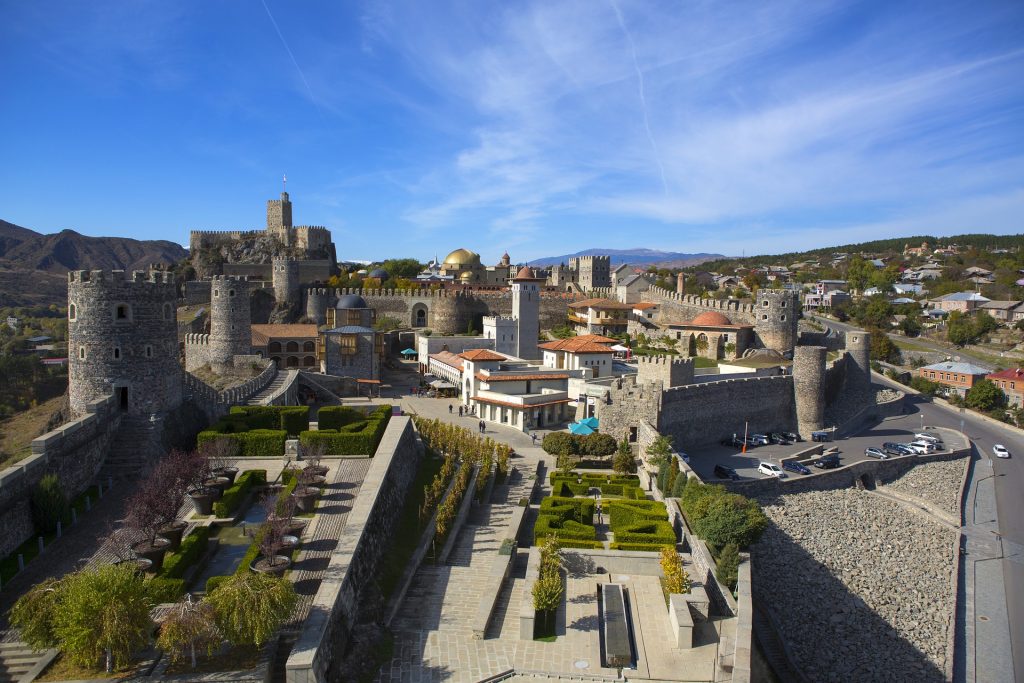
Alongside the fortress, Akhaltsikhe also has a few churches and synagogues worth seeing, but given you’ll still have another long marshrutka journey ahead of you, we recommend you stick to the castle. And the reason why we say that is because there is another very special place you should not miss, located not too far away from Akhaltsikhe. That being said, your next step is to arrange a taxi (80 GEL round-trip + waiting time) to help cover the 60 km distance to Vardzia Cave City (15 GEL), an enormous monastery directly carved into the wall of a cliff. Much like Uplistsikhe, Vardzia’s buildings were also shaped from the rock surface, with multiple churches, temples and halls connected through a system of tunnels, terraces and staircases. Although only a fraction of its original size remains, the monastery is still quite impressive, stretching for over half a kilometer along the cliff.
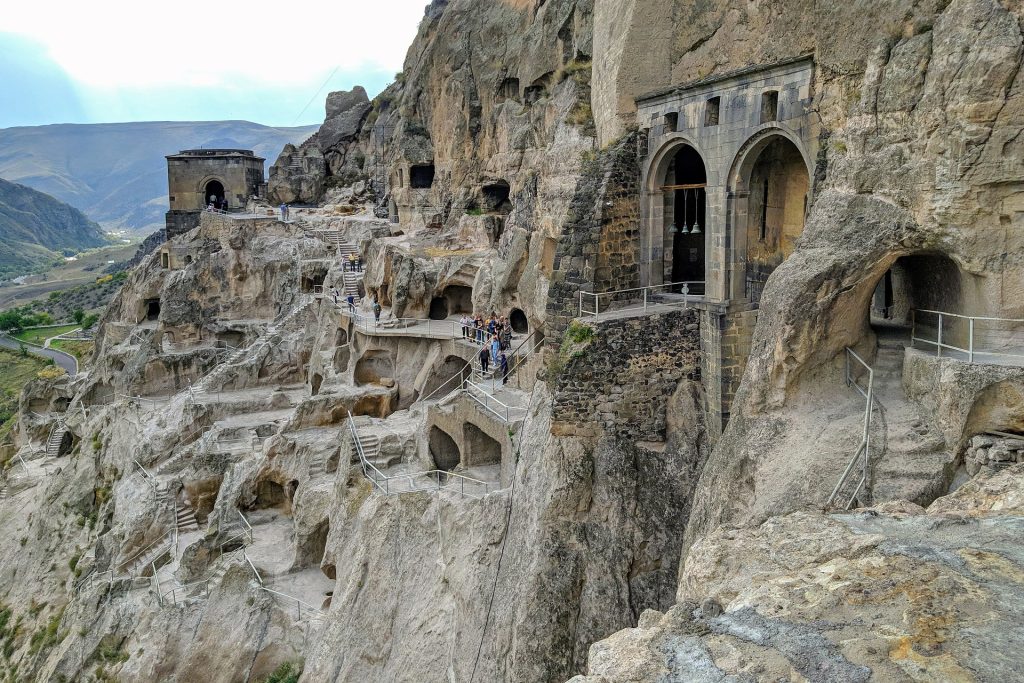
Back in Akhaltsikhe, it is then time to board the second marshrutka of the day, this time bound for Kutaisi, where you’ll spend the night.
Eighth day wrap-up:
- Akhaltsikhe
- Rabati Castle
- Vardzia Cave City
Where to eat in Georgia – Best restaurants in Akhaltsikhe:
- Old Bar (Georgian and Armenian)
- Mimino (Georgian traditional)
- Old Rabati (Georgian traditional)
- Kantora 19 (Asian + pizzas + hamburgers)
- SL Company (varied)
Georgia 10-Day Itinerary: Day 9 – Kutaisi

The third-largest city in Georgia, Kutaisi is often overlooked in favor of more popular destinations. Even for the many visitors who happen to land here thanks to the low-cost flights operated by Wizz Air, it’s not uncommon for tourists to simply head straight to Tbilisi or Batumi. Big mistake – which is why today you’ll be exploring this city, famous for its multicultural legacy. A melting point that saw the arrival of Armenians, Russians, Jews and even Catholic missionaries! However, before delving deep into Kutaisi’s history, kickstart your day by taking one of the vintage Georgian cable cars at the station near the White Bridge, for a brief 30-second journey that will take you to the Besik Gabashvili Amusement Park, a small space with Soviet-era attractions and a delightful view of the city. Staying on this side of the river, a short walk leads to Bagrati Cathedral, one of the biggest attractions in Kutaisi. Perched atop a hill, visiting this imposing 11th-century church is a must, both for its architecture and interior frescoes but also for the breathtaking panoramic view (the best in Kutaisi) from its ancient wall. From there, you’ll make your way down and cross the Rioni River again, this time towards the historic center, where you’ll start by visiting the Green Bazaar, the city’s main market. Beyond the typical bustling market experience, the bazaar is also home to the Kolkhida, a giant orange mural, intricately sculpted with depictions of important figures and scenes from Kutaisi’s history.
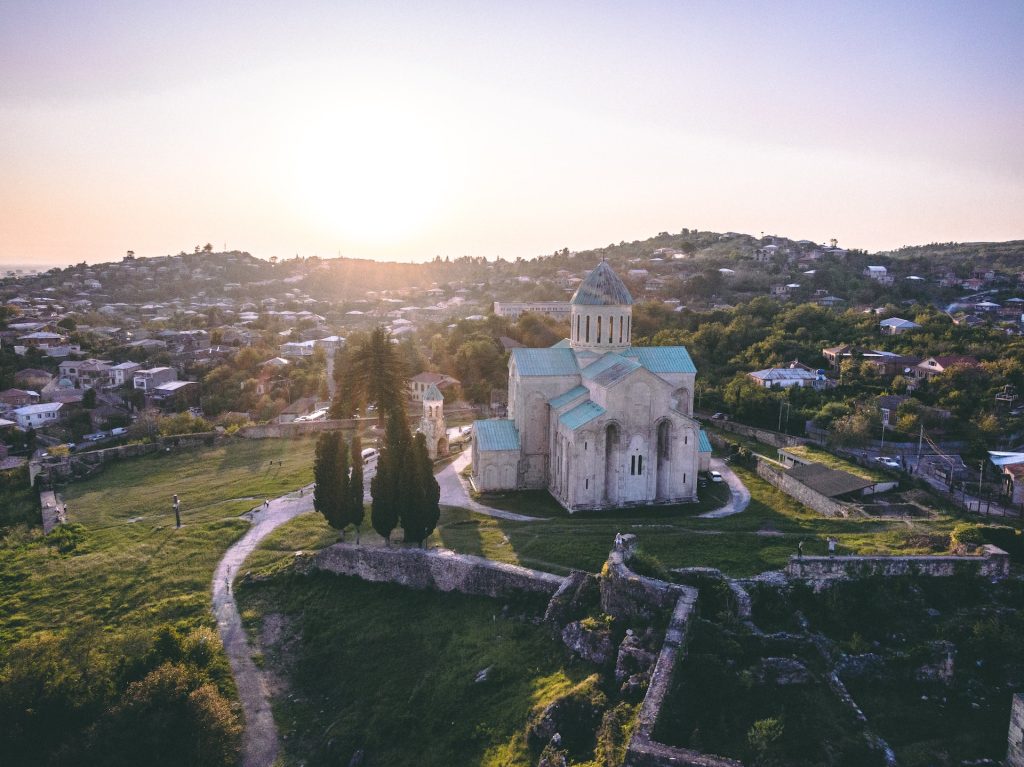
A short distance further south and you’ll enter the Royal District, arguably the most picturesque neighborhood in the city, boasting plenty of classical architecture. Nevertheless, this district also hosts the city’s largest urban art center, subtly tucked away in a small passage known as the Wall of Love. Continue by walking through Kutaisi Park and you’ll eventually find yourself at the Colchis Fountain, the central monument in the city’s main square and a tribute to the first great Hellenic civilization (the Colchians) that inhabited this region of Georgia. A bit to the north, and you’ll then enter the different neighborhoods that once served as home to the extensive communities of Armenian and Jews, as well as to Catholic missionaries (the latter district known as the “French Quarter”). While there aren’t many differences in architecture setting these quarters apart, the presence of different places of worship certainly does the trick. As such, you can wander through these different districts and visit the Holy Annunciation Temple (originally Catholic, now Orthodox), the Armenian Church of Saint George and the Kutaisi Great Synagogue.
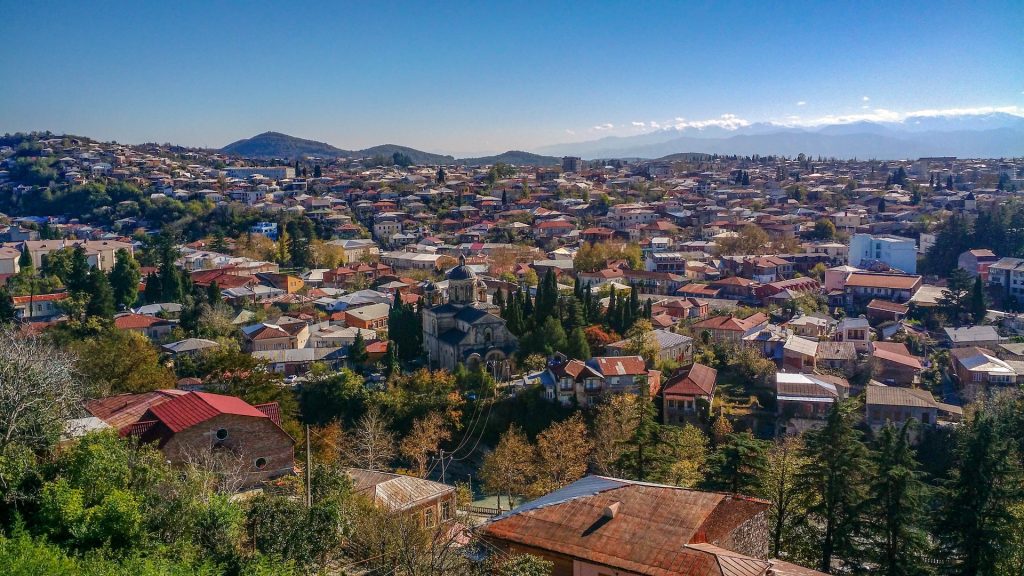
To cap off your day, no visit to Kutaisi is complete without stopping at the legendary Gelati Monastery, one of Georgia’s four UNESCO World Heritage Sites. As one of the oldest and most significant places of worship in the country, this monastery certainly excels when it comes to historical importance, location (great views) and architecture/looks. No matter how many monasteries you’ve visited in Georgia so far, this one has to go into the list! Since the Gelati Monastery is located more than 8 km from Kutaisi’s center, you’ll be better off by saving your energy and flagging a taxi. Fares typically range from 35 to 45 GEL for the round-trip, including a waiting time of 30 to 45 minutes.

Ninth day wrap-up:
- Besik Gabashvili Amusement Park (cable car)
- Bagrati Cathedral
- Green Bazar
- Kolkhida
- Royal District (Tsminda Nino Street, Kantselebi Street and Alexander Pushkin Street)
- Wall of Love
- Kutaisi Park
- Colchis Fountain
- Holy Annunciation Temple
- Armenian Church of Saint George
- Kutaisi Great Synagogue
- Gelati Monastery
Where to eat in Georgia – Best restaurants in Kutaisi:
- Toma’s Wine Cellar (Georgian traditional)
- Cafe Tiflisi (Georgian traditional)
- Lilestan (Georgian traditional + pizza and pasta)
- Sisters (Georgian traditional)
- At Home (Georgian traditional)
- Palaty (Georgian traditional)
- Tea House Foe-Foe (tea salon – pancakes, waffles and crepes)
Georgia 10-Day Itinerary: Day 10 – The journey back to Tbilisi

As your final day in Georgia includes another nagging 3-hour journey on a less-than-comfortable marshrutka to Tbilisi, there’s nothing in the books to keep you busy. The goal is to make sure you arrive in the capital feeling well-rested, and, most importantly, in time for your return flight.
“Madloba” for your visit!
Tenth day wrap-up:
- Road to Tbilisi
Traveling soon? Get your Holafly eSIM with a 5% discount for unlimited internet access in any destination. No more worrying about roaming charges or finding local SIM cards. Enjoy unlimited data and stay connected with ease. Order your Holafly eSIM now »
Heymondo offers a wide range of travel assistance insurance policies. They combine the best quality, service and price with various levels of coverage, so you’re covered on your weekend getaways and long trips. Buy insurance »








